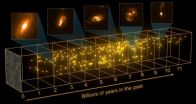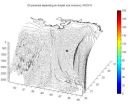(Press-News.org) SAN FRANCISCO - Scientists from the Department of Energy's Pacific Northwest National Laboratory will present a variety of alternative energy-related research at the 2012 American Geophysical Union Fall Meeting, which runs Monday, Dec. 3 through Friday, Dec. 7 at the Moscone Convention Center in San Francisco. Topics to be discussed include improving solar power forecasting, measuring the resources needed to grow algae for biofuel and predicting the environmental impacts of ocean energy. Summaries of some of PNNL's noteworthy presentations are below.
Forecasting clouds to improve solar power
The sun's fleeting nature has limited our ability to turn sunshine into electricity. While we can easily foretell when the sun will rise and fall each day, predicting the intermittent daytime shading created by continually morphing clouds is much more difficult. Repeated appearing and disappearing acts by clouds lead to large fluctuations in solar power generation, which makes balancing supply and demand on the power grid a challenge. But now PNNL scientists propose using a new approach to predict clouds from 5 minutes to about an hour ahead of time, giving grid operators a chance to adapt before solar power ramps up or down. Initially created for climate research, the approach uses an instrument called a total/diffuse pyranometer. Depending on their size, shape and thickness, clouds can affect light coming from the sun in many different ways to produce varying amounts of sunshine. Total/diffuse pyranometers enable scientists to measure direct and indirect solar radiation, both of which are used in different types of solar power generation. Next, the new approach uses a PNNL-developed method to forecast the clouds that will appear in the near future, what properties those clouds will have and how much direct and indirect solar radiation will make it past the clouds and onto the earth's surface. PNNL's Chuck Long will present the research.
A24E-04: "Near-term forecasting of solar total and direct irradiance for solar energy applications," 5-5:15 p.m., Tuesday, Dec. 4, Room 3008, Moscone West. Media contact: Franny White.
Digging for details on growing algae for biofuel
Algae have been touted as a promising source of renewable fuel, but questions remain about whether the U.S. has the resources needed to grow it on a large scale. Ongoing PNNL research indicates that algal biofuel's sustainability can be increased by carefully analyzing the resources available at specific growing sites. Current efforts are building on earlier PNNL research, which involved developing a detailed map of the nation's freshwater and land resources to calculate algal biofuel production potential. PNNL researchers are digging deeper by also examining alternative water sources such as seawater, the nutrients needed to grow algae, real estate prices and costs to transport algal oil to existing refineries. The combined information will help determine the financial and environmental bottom lines of U.S. algal biofuel. PNNL's Mark Wigmosta will present a poster that describes early results, including that the Gulf Coast region generally has the nation's best water supplies and climate for growing algae.
H53H-1632: "A high-resolution national microalgae biofuel production and resource assessment," 1:40-6 p.m., Friday, Dec. 7, Hall A-C, Moscone South. Media contact: Franny White.
Modeling tidal power's environmental effect
Extracting energy from the natural ebb and flow of the ocean's tides could help wean the world off of greenhouse gas-producing fossil fuels. But, with very few tidal power projects in existence, it's difficult to know how such efforts could affect the marine environment. To help answer that question, PNNL scientists developed a detailed, 3-D computer model of a hypothetical bay where seawater enters through a coastal channel. They added tidal turbines to the digitized channel and ran simulations to find out how water flow could be impacted. They found that installing large numbers of turbines can decrease the flushing rate -- the amount of time it takes to replace the bay's water with new ocean water. The longer it takes to flush out a bay, the longer it takes to remove contaminants from river runoff and human activity. This could worsen the conditions of bays already experiencing low levels of dissolved oxygen. On the other hand, simulations also showed turbines increase mixing in the water column, which could breathe more life into a bay's lower waters by transporting more oxygen from the surface. PNNL's Taiping Wang will discuss the computer model and some of its simulation results.
OS53D-07: "A Modeling Study of In-stream Tidal Energy Extraction and Its Potential Environmental Impacts in a Tidal Channel and Bay System," 3:10-3:25 p.m., Friday, Dec. 7, Room 3024, Moscone West. Media contact: Franny White.
###
Interdisciplinary teams at Pacific Northwest National Laboratory address many of America's most pressing issues in energy, the environment and national security through advances in basic and applied science. PNNL employs 4,500 staff, has an annual budget of nearly $1 billion, and has been managed for the U.S. Department of Energy by Ohio-based Battelle since the laboratory's inception in 1965. For more, visit the PNNL's News Center, or follow PNNL on Facebook, LinkedIn and Twitter.
Sunshine, biofuel and the tides, oh my!
PNNL discusses alternative energy options at AGU
2012-12-04
ELSE PRESS RELEASES FROM THIS DATE:
Herschel and Keck take census of the invisible Universe
2012-12-04
By combining the observing powers of ESA's Herschel space observatory and the ground-based Keck telescopes, astronomers have characterised hundreds of previously unseen starburst galaxies, revealing extraordinary high star-formation rates across the history of the Universe.
Starburst galaxies give birth to hundreds of solar masses' worth of stars each year in short-lived but intense events.
By comparison, our own Milky Way Galaxy on average produces the equivalent of only one Sun-like star per year.
Starburst galaxies generate so much starlight that they should outshine ...
Overprescribing of opioids impacts patient safety and public health
2012-12-04
A Viewpoint article published recently in the Journal of the American Medical Association suggests that the clinical practice of prescribing amphetamines, opioids, and benzodiazepines to treat chronic pain may be contributing to the increase in fatal drug overdoses and the likelihood that those drugs will be diverted to the illegal market. "Rethinking Opioid Prescribing to Protect Patient Safety and Public Health" was authored by Johns Hopkins Bloomberg School of Public Health researchers G. Caleb Alexander, MD, MS, and Daniel Webster, ScD, MPH, and Stefan P. Kruszewski, ...
Targeting neurotransmitter may help treat gastrointestinal conditions
2012-12-04
HERSHEY, Pa. -- Selective targeting of the neurotransmitter that differentially affects brain cells that control the two distinct functions of the pancreas may allow for new medication therapies for conditions like diabetes, dyspepsia and gastro-esophageal reflux, according to Penn State College of Medicine researchers.
"This study differs from what's been reported previously about brain neurons that control the gastrointestinal tract," said R. Alberto Travagli, professor, Department of Neural and Behavioral Sciences, and lead investigator. "It provides further support ...
Telecommuting increases work hours and blurs boundary between work and home, new study shows
2012-12-04
AUSTIN, Texas — With fluctuating gas prices and the increasing call for work-life balance, telecommuting has become an attractive option for busy professionals. Yet according to a new study from The University of Texas at Austin, for most employees who work remotely, telecommuting equates to working more hours.
The study, co-authored by Jennifer Glass, professor in the Department of Sociology and the Population Research Center, shows that most of the 30 percent of respondents who work from home add five to seven hours to their workweek compared with those who work exclusively ...
Infants learn to look and look to learn
2012-12-04
Researchers at the University of Iowa have documented an activity by infants that begins nearly from birth: They learn by taking inventory of the things they see.
In a new paper, the psychologists contend that infants create knowledge by looking at and learning about their surroundings. The activities should be viewed as intertwined, rather than considered separately, to fully appreciate how infants gain knowledge and how that knowledge is seared into memory.
"The link between looking and learning is much more intricate than what people have assumed," says John Spencer, ...
Improving chemotherapy effectiveness by acting on the immune system
2012-12-04
This press release is available in French. These results reveal how the immune system can then limit the effectiveness of some cancer chemotherapies. The researchers now intend to block the molecules responsible for negative immune system activation to increase the efficiency of chemotherapy. A clinical trial to test this hypothesis should begin very soon.
Chemotherapy is one of the most frequently used treatments to eliminate cancerous cells. These drugs kill all cells that are multiplying, or block their proliferation (for example, cells responsible for hair growth, ...
Numerical study suggests subsea injection of chemicals didn't prevent oil from rising to sea surface
2012-12-04
MIAMI — December 4, 2012 - The 2010 blowout of the Macondo well in the waters of the Gulf of Mexico resulted in the region's largest oil spill in U.S. history. As the Deepwater Horizon (DWH) incident unfolded, in an effort to prevent the oil from coming to the surface and reaching coastal and marsh ecosystems, chemical dispersants were injected at the wellhead. These powerful dispersants, typically used to break up oil slicks at the sea surface had never been used in such large quantities and over such a prolonged period of time in the deep ocean.
A new study published ...
New study reveals lions are rapidly losing ground in Africa
2012-12-04
A new study released this week confirms that lions are rapidly and literally losing ground across Africa's once-thriving savannahs due to burgeoning human population growth and subsequent, massive land-use conversion. Representing the most comprehensive assessment of the state and vitality of African savannah habitat to date, the report maintains that the lion has lost 75% of its original natural habitat in Africa – a reduction that has devastated lion populations across the continent.
Co-authored by Panthera's Lion Program Survey Coordinator, Dr. Philipp Henschel, and ...
Annals of Internal Medicine tip sheet for Dec. 4, 2012
2012-12-04
1. American College of Physicians Says Upper Endoscopy Overused in Patients with Reflux
Routine use of upper endoscopy for most patients with gastroesophageal reflux disease (GERD) does not improve patient health, is associated with preventable harms, and may lead to unnecessary interventions and costs, says the American College of Physicians (ACP) Clinical Guidelines Committee in a new evidence-based clinical policy paper. Heartburn, a symptom of GERD, is a common reason for people to see a doctor. Long term complications of GERD can include scarring of the esophagus ...
American College of Physicians: Upper endoscopy is overused in patients with heartburn
2012-12-04
PHILADELPHIA, December 4, 2012 -- Heartburn is one of the most common reasons for people to see a doctor, and some physicians often use upper endoscopy to diagnose and manage gastroesophageal reflux disease (GERD). But most patients do not require the procedure unless other serious symptoms are present, according to the American College of Physicians (ACP) Clinical Guidelines Committee in a new evidence-based clinical policy paper published today in Annals of Internal Medicine.
"The evidence indicates that upper endoscopy is indicated in patients with heartburn only when ...
LAST 30 PRESS RELEASES:
iPS cells from dish to freezer and back
Deep neural networks enable accurate pricing of American options under stochastic volatility
Collective risk resonance in Chinese stock sectors uncovered through higher-order network analysis
Does CPU impact systemic risk contributions of Chinese sectors? Evidence from mixed frequency methods with asymmetric tail long memory
General intelligence framework to predict virus adaptation based on a genome language model
Antibiotic resistance is ancient, ecological, and deeply connected to human activity, new review shows
Vapes, pouches, heated tobacco, shisha, cigarettes: nicotine in all forms is toxic to the heart and blood vessels
From powder to planet: University of Modena engineers forge a low-carbon future for advanced metal manufacturing
Super strain-resistant superconductors
Pre-school health programme does not improve children’s diet or physical activity, prompting call for policy changes, study finds
Autumn clock change linked to reduction in certain health conditions
AI images of doctors can exaggerate and reinforce existing stereotypes
Where medicine meets melody – how lullabies help babies and parents in intensive care
We may never be able to tell if AI becomes conscious, argues philosopher
AI video translation shows promise but humans still hold the edge
Deep ocean earthquakes drive Southern Ocean’s massive phytoplankton blooms, study finds
Without campus leftovers to pick through, the beaks of this bird changed shape during the pandemic
High-dose antibiotic does not reduce mortality in tuberculous meningitis
How many insects fly in the sky above the USA?
Could cheese protect your brain health?
Who faces more difficulty recovering from stroke?
Colliding galaxies create the brightest, fastest growing black holes at their center
New BrainHealth research reveals tradeoffs on sleep with cannabis use for chronic pain
Aging-US now on ResearchGate, enhancing visibility for authors and readers
'Molecular glue' stabilizes protein that inhibits development of non-small cell lung cancer
Mount Sinai Health System is recognized in 2025 Chime Digital Health Most Wired survey
From prey to predator: How carnivores spread beneficial fungi
Menopause symptoms may be frequent and have negative effects, according to female endurance athletes
US Congressmembers’ responses on X to mass shooting events differ along party lines
KAIST-UEL team develops “origami” airless wheel to explore lunar caves
[Press-News.org] Sunshine, biofuel and the tides, oh my!PNNL discusses alternative energy options at AGU



